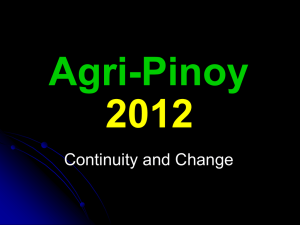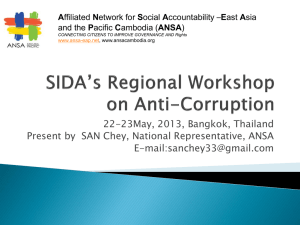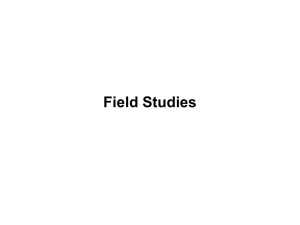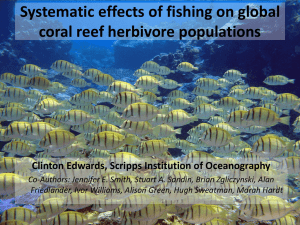Fisheries Aid-Effectiveness - Africa Platform for Development
advertisement
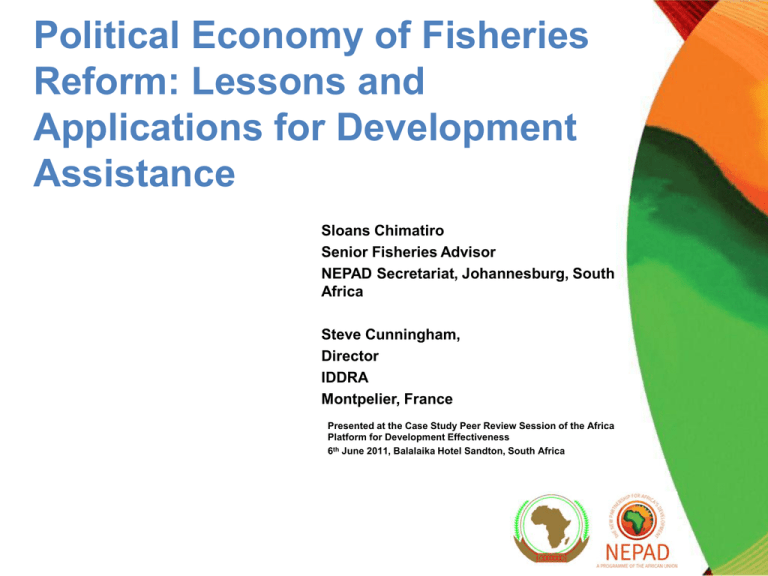
Political Economy of Fisheries Reform: Lessons and Applications for Development Assistance Sloans Chimatiro Senior Fisheries Advisor NEPAD Secretariat, Johannesburg, South Africa Steve Cunningham, Director IDDRA Montpelier, France Presented at the Case Study Peer Review Session of the Africa Platform for Development Effectiveness 6th June 2011, Balalaika Hotel Sandton, South Africa Presentation outline • Background to the study • Methodology • Factors which have influenced fisheries aid to Africa • Levels of fisheries aid to Africa (1973-2001) • Analysis of performance of fisheries aid • Challenges to effectiveness of fisheries aid • Recommendations Background • • • This study is part of a collaborative global study between NEPAD Agency and the World Bank entitled “The political economy of natural resource use: lessons for fisheries reforms”; and subsidiary study known as “The political economy of fisheries reform: lessons and applications for development assistance”. The studies aim at drawing lessons to inform the architecture of the donor support to African fisheries policy and governance reforms. The studies are based on the hypothesis that: “the key reason for the disconnect between fisheries development aid and impact of fisheries (natural resources) sustainability is that by and large development projects have lacked a solid theoretical underpinning” Methodology • • • • Preparation of background paper on Africa, as part of the World Bank’s global study Commissioned four case studies: Ghana (Anglophone, West Africa, less aid); Mozambique (Lusophone, Southern Africa, a lot of aid); Senegal (Francophone, West Africa, a lot of aid); and Uganda (Anglophone, East Africa, a lot of aid) Description of country’s aid structure; fisheries performance in terms of formulation of projects, and development impact Economic theory of overexploitation of fisheries and suggestions for effective involvement of aid Factors which have influenced fisheries aid to Africa • • • Growing scarcity of fish globally has focused interest in Africa The powerful fishing entities in Europe and Asia represents a strong political lobby to sustain their industry “Aid Business” has become more pluralistic, comprising donors, aid agencies, intermediaries in recipient countries Levels of fisheries aid to Africa • Using data provided by the World Bank, we found that African fisheries have received substantial aid (US $4.6 billion between 1973-2001) Levels of fisheries aid to Africa Table 3. Fisheries Development Aid in Africa – Top 10 Donors Donor US $ millions Donor No. projects Japan 799 France 294 France 432 EU-OECD 206 Sweden 392 Sweden 167 Italy 312 Japan 165 EU-OECD 309 Norway 161 AFDB 281 Italy 131 Norway 272 Canada 117 West Germany 234 Netherlands 100 World Bank (IDA) 178 Belgium 84 World Bank (IBRD) 145 Spain 81 Total 3,354 1,506 Source: Calculations based on database developed by Hicks (2007) Levels of fisheries aid to Africa Table 4. Fisheries Development Aid in Africa – Top Recipients Recipient Total Recipient Number of (US $ millions) projects Mozambique 385 Mozambique 147 Angola 366 Angola 106 Morocco 342 Senegal 103 Senegal 302 Madagascar 75 Mauritania 203 Mauritania 69 Egypt 191 Tanzania 64 Madagascar 190 Namibia 60 Tunisia 178 Morocco 59 Somalia 149 Source: Calculations based on database developed by Hicks (2007) Levels of fisheries aid to Africa Parameter Fish utilization and trade Global 110 million tones (77% catch) used for human food; Trade: 37% catch (value US $86 billion); exports grown by 32% (2000-06); 49% exports from DCs; Africa - Africa is a net exporter of fish (since 1985); - Total exports: US $4.4 billion (5% global) - Total imports: US $679 million (<1% global) - 19.4 % agric exports on average; Supply and - Global per capita fish supply increased to 16.7 kg in 2006 - Fish supply in SSA is static (8.3 consumption (from 16.4 kg in 2005); kg/capita); - fish contributes 15% global protein supplies; - Mean fish consumption by country : 21% daily protein; - Ghana (65%), Sierra Leone (63%), Gambia (57%), Nigeria (36%), South Africa (8%); Policy and - Policy development and fisheries management are major There have been few objective management challenges; assessments of policy and fisheries key issues: management in Africa; - limited institutional capacity; There are some recent indicators: - role of public sector reform and better governance, and (1) Fisheries development policy: ODA; - PRSPs – fisheries quality rating: 32% - Concern over fishing capacity and subsidies; - WB-CAS – rating: 6% - Also in key areas (mainstreaming EcSA and PrecA, - EU-CSP –rating: 10% bycatch, bottom trawl regulations, shark - Mean value : 16% fisheries, IUU); (2) Fisheries management : - prioritization of capacity-building; - Formulation/Implementation mean : - role of international and regional dimensions. 34% (3) Fisheries management (McWhinnie Table 3. Comparison of the status of global and African fisheries and aquaculture fisheries rating): Source: Cunningham and Neiland (2009), adapted from FAO-SOFIA - Morocco (33%) - Namibia (50%) - South Africa (50%) Challenges to effective aid- Key issues • • • • Lack of ownership of the process of identifying and formulating projects by the African fisheries institutions, including Ministries of Fisheries and fish-dependent communities. Over the past decades, capacity development was never emphasised in fisheries development aid (recently this has changed). Volume of aid and aid targets have been influenced by the prevailing development narrative with particular focus on infrastructure (e.g. Fishing harbours and fleets). With evidence that choice of targets were consultative; Fisheries policy has been influenced by international development narratives for natural resources; with no efforts have to link fisheries to the wider national macro-economic development policies. Challenges to effective aid- Key issues • • Multiplicity of channels of aid has overwhelmed the capacity of recipient countries to coordinate and make good use of aid The performance of fisheries aid is difficult to discern precisely in all the casestudies. In all four case study countries, the fisheries are in general currently characterised by: overexploitation, both economic and biological, which suggests that the overall contribution of fisheries aid aimed at fisheries development has not been very successful, in many cases, the fisheries are in poor state than before. effective fisheries management systems have been not been established, and the problems associated with regulated open access have emerged including weak economic performance, declining stock levels and social instability. Recommendations • • • • Likely use of aid as a source of investment, should include a detailed assessment, at an early stage, of the potential benefits which can be realised on a sustainable basis from a well-managed fisheries sector. Aid-funded projects should be well-designed and provide the future vision and direction for fisheries sectoral development through the clear identification of policy objectives and implementation mechanisms. The prioritisation of fisheries aid programmes and projects should be clearly linked and flow from the sectoral policy framework – objectives and mechanisms. The performance of fisheries aid investments should be carefully monitored, assessed and evaluated: at a project level (i.e. did the project achieve its stated objectives?); and in relation to sectoral policy goals (i.e. did the investment have a positive and desired impact in relation to policy goals?); Recommendations • • • • Fisheries aid should be part of this dynamic process, with a need to anticipate and plan ahead for likely investments required over time; The linkage between national macro-economic policy and fisheries policy must be established and understood in order to ensure that fisheries aid is effectively prioritised and used within the overall context of national development. Fisheries aid for improved fisheries management should give proper consideration to the central role of resource rent in fisheries exploitation (both a benefit and an incentive to overexploit under weak management) and addressed using appropriate management approaches (e.g. wealth-based fisheries management). Economic analysis should provide the essential theoretical and empirical framework; The relationship between fisheries reform and fisheries aid should also be well-defined in the future; including the benefit & cost of reform, and the need for aid where appropriate over time given that fisheries reform can take decades rather than just years. Pix: S. Chimatiro www.nepad.org www.africanfisheries.org www.stopillegalfishing.com

